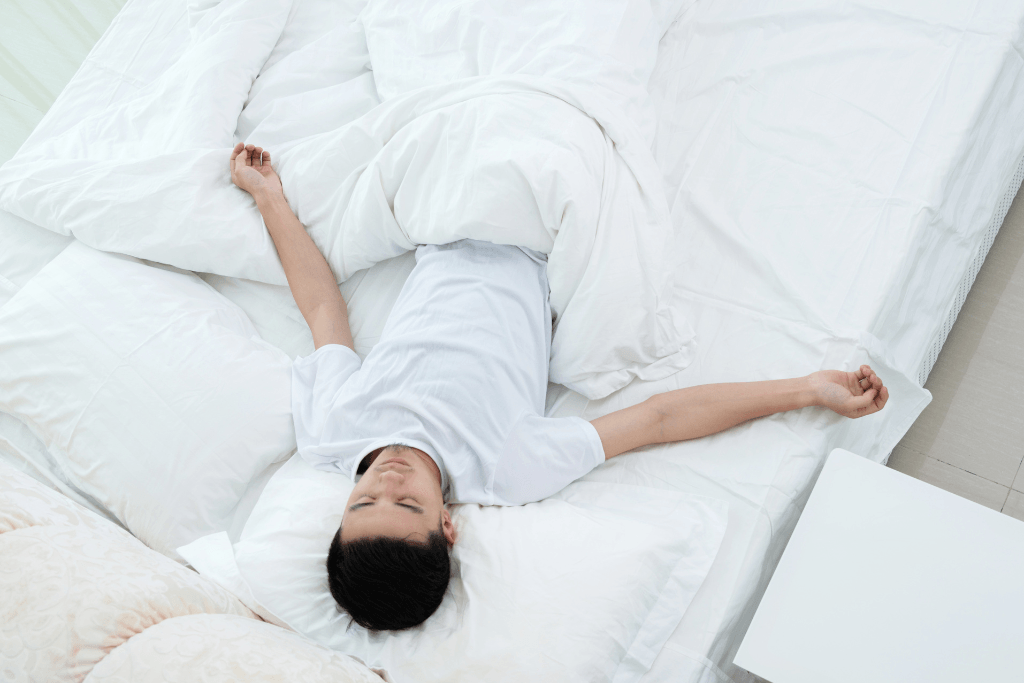Whether you sleep on your back, side or stomach, sleep positions can reveal more than you think. Learn what your sleep position says about your personality.
Sleep, glorious sleep! It’s something we all need, and yet, how much do we truly understand how our slumbers cradle us each night? For many, finding the best sleep is like searching for a comfortable pillow in a sea of foam options. But what if the key to a night of healthy sleep lies not just in the mattress or the room’s temperature but in the sleep position itself?
Surprisingly, the position you rest your head at night can say a lot about you. Whether it’s a full-on sprawl or a cozy curl, your sleeping position might be doing more than just reflecting your personality; it could be speaking volumes about your health too! It’s a concept that’s as fascinating as it is practical. How does sleep position affect your health? Can the best sleeping position make a difference in avoiding back pain or promoting a more refreshing slumber?
These questions and more are what we’re going to explore in this comprehensive guide. We’ll dive into the world of sleep and uncover the connections between how your sleep position affects your nightly rest and overall well-being. And hey, it might even give you some insight into the quirks of your character! So grab your coziest blanket and your curiosity as we embark on a journey to discover the secrets hidden beneath the pillow. In the search for the best sleeping position for your health, you might just find a new perspective on what it means to catch some quality z’s.
Now, who’s ready to dream a little dream and find out how their sleep position affects their life? Let’s get started, shall we?
The Importance of a Good Night’s Sleep
Sleep is not just a restorative process for the weary body; it’s an essential function that affects nearly every system within us. Getting a good night’s sleep is vital to our overall health, from the glow in our skin to the gears in our brain. Here’s how it all ties together:
Sleep isn’t merely about recharging the body; it plays a critical role in managing and preventing various health conditions. From cardiovascular diseases to mental health disorders, the quality and quantity of sleep can influence the severity and progression of several conditions. Poor sleep can worsen chronic pain, increase stress hormones, and lead to weight gain, affecting chronic diseases like diabetes and hypertension.
Sleep and Brain Health
Your brain is like a busy office; sleep is its nightly maintenance crew. During sleep, the brain clears out waste products and makes vital repairs. It also processes memories and emotions, waking us with a fresh perspective. Disruptions in sleep patterns can lead to cognitive decline, memory issues, and even an increased risk of neurological disorders like Alzheimer’s disease. A healthy sleep routine isn’t just smart; it’s essential for brain health.
Sleep and Overall Health
Sleep touches every part of our lives. It’s interwoven with our immune system, metabolism, and emotional well-being. Lack of sleep can weaken our immune response, making us more susceptible to infections. It can also affect our mood, leading to irritability and even depression. Sleep fuels our days, nourishes our bodies, and cultivates our minds. It’s not a passive state but an active, vital part of our overall health.
In conclusion, a good night’s sleep is not a luxury; it’s a necessity. It’s more than just shutting our eyes and drifting off; it’s a complex process that plays a crucial role in our overall wellness. The positions we choose, the hours we allocate, and the habits we develop around sleep are not just about comfort; they’re about creating a foundation for a healthy, happy life. Whether you’re a back sleeper, a side sleeper, or a freestyle dream adventurer, understanding the intricacies of sleep can pave the way to better health and a brighter tomorrow.
Sleep Positions and Health
Sleep positions aren’t just a matter of personal comfort; they can also be crucial to your overall well-being. How you sleep at night can profoundly affect various health aspects, including the likelihood of experiencing back pain, the natural alignment of your spine, and even your digestion. Here’s a deep dive into the health implications of different sleep positions:
Back Sleepers

Ah, the dignified back sleepers! You, folks, have mastered the art of looking professional even in sleep, lying flat on your back like a boardroom presentation. If the “correct position” for sleep had a poster child, it might be you. Sleeping on your back supports the natural curve of your spine, and the sleep foundation itself often recommends it. But be warned; it’s not always the snazziest way to sleep if snoring turns into your nighttime concert. If obstructive sleep is a concern, you can tweak that position to keep the airway clear. But hey, who needs to breathe, right?
Benefits and Drawbacks: Sleeping on the back can help align the head, neck, and spine, reducing the risk of neck or back pain. But for some, it might lead to snoring or even sleep apnea.
Impact on Back Pain: This position helps avoid back pain by maintaining the spine’s natural alignment. It reduces pressure on the lower back, which can lead to lower back pain if neglected.
Personality Reflection: Back sleepers are often considered confident and self-assured individuals who take life head-on.
Tips for Healthy Sleep: Using a supportive pillow that doesn’t elevate the head too much and lying on your back with a pillow beneath the knees can ensure comfort and health benefits.
Left Side Sleepers

Left Side Sleepers, the thinkers of the sleep world! Many people find this the best position to ponder life’s mysteries or avoid acid reflux. This position can be pretty health-conscious but doesn’t always play nice with the low back. And remember, don’t turn that head to one side too much; you wouldn’t want to wake up with a crick in your neck, looking like a confused puppy all day.
Benefits and Drawbacks: This position aids in reducing acid reflux but can sometimes put pressure on the stomach and lungs. It may also strain the lower back if not done with proper support.
Impact on Back Pain: Left side sleeping may cause pain in the lower back if the spine twists. Proper alignment and support can mitigate this risk.
Personality Reflection: Left-side sleepers may be seen as thoughtful and introspective, often weighing different aspects of life carefully.
Tips for Healthy Sleep: Using a firm pillow and keeping the legs slightly bent can ensure proper alignment and avoid back pain.
Right Side Sleepers

Right Side Sleepers, you’re like the left-side sleepers but just a tad contrarian. You have a favorite position, but it can be better for some, especially if heartburn loves to crash your sleep party. This side sleep may cause your dreams to become a spicy adventure, but hey, at least you’re not prone sleeping, right?
Benefits and Drawbacks: While it may be comfortable for many, right-side sleeping can aggravate heartburn and potentially put a strain on your back.
Impact on Back Pain: Without proper support, this position might create imbalances, leading to pain in the lower back.
Personality Reflection: Right side sleepers are often perceived as adaptable and easy-going, finding joy in life’s simple pleasures.
Tips for Healthy Sleep:
Maintaining alignment with supportive pillows can prevent back and neck pain.
Stomach Sleepers

Stomach Sleepers, oh, you rebels of the sleep world! Sleeping on your stomach might seem like the comfy position, but it’s often dubbed the worst position for your spine. You’re the mavericks who defy the sleep quality norms, but watch out; lying on your stomach might just put your neck in a twist. It’s like trying to watch TV and read a book at the same time – possible but not advisable.
Benefits and Drawbacks: While it may reduce snoring, sleeping in this way flattens the natural curve of your back, potentially leading to lower back pain.
Impact on Back Pain: The strain on your back from lying flat on your back can cause issues in the lower back area.
Personality Reflection: Stomach sleepers may be seen as bold and sociable, always seeking new experiences.
Tips for Healthy Sleep: Using a thin pillow or no pillow at all and placing a pillow under the hips can mitigate some of the risks associated with this position.
Fetal Position Sleepers

Fetal Position Sleepers, you’ve taken “sleep like a baby” a bit too literally, haven’t you? Curled with your knees slightly toward your chest and arms close to your body, this popular sleeping position is twice as likely as men to sleep in among women. But beware, the fetal position might feel like a hug from a teddy bear but could also leave you feeling like you’ve been squeezed by a bear if done wrong.
Benefits and Drawbacks: While comforting, it might restrict deep breathing and put undue pressure on the back and neck.
Impact on Back Pain: Curled too tightly may lead to back and neck pain.
Personality Reflection: Fetal position sleepers often display a sensitive and empathetic nature.
Tips for Healthy Sleep: Keeping the body slightly relaxed, rather than tightly curled, helps maintain health in this position.
Starfish Sleepers

Starfish Sleepers, you’re the folks who just can’t be confined. Spread out and embracing the entire bed, your sleep style says, “I’m here, and I need space!” It’s a great position to sleep if you’re auditioning for a sea creature role in your dreams, but make sure you’re not hogging all the covers. This position also supports the natural curve, but remember that you’re in bed, not on a beach!
Benefits and Drawbacks: Lying on your back with arms and legs spread out promotes spinal alignment but may lead to snoring.
Impact on Back Pain: By maintaining the natural curve of your back, this position can help avoid back pain.
Personality Reflection: Starfish sleepers are often seen as friendly and unselfish, always ready to lend a hand.
Tips for Healthy Sleep: Careful pillow placement can keep the neck in alignment, preventing neck or back pain.
Spooners

Spooners, you romantic souls! You believe that the closest way to a person’s heart is to sleep so close you’re basically one person. This common sleep position is cozy and intimate, but remember, it’s not the best way to support the neutral curve of your back. It’s a classic example of love conquering ergonomics. Sweet dreams, you lovebirds, just don’t complain if you wake up feeling like a human pretzel!
Benefits and Drawbacks: While intimate and comforting, it can lead to sore limbs or spine misalignment if not done with care.
Impact on Back Pain: A poorly positioned spooning can put a strain on your back, leading to discomfort.
Personality Reflection: Spooners are seen as affectionate and nurturing, valuing close connections.
Tips for Healthy Sleep: Adjusting arm and leg positions to maintain alignment helps to maximize comfort and minimize health risks.
Tips for Finding the Best Sleeping Position for Your Health
We spend roughly a third of our lives asleep, and finding the right position to rest in is paramount to our well-being. Whether you’re a starfish sprawler or a fetal position curler, how you sleep affects your body and mind. Here’s a comprehensive guide to finding the best sleeping position for your health:
General Guidelines for Choosing the Right Sleep Position
The quest for the ideal sleeping position is like finding the perfect pair of jeans. It’s personal, sometimes elusive, and can make all the difference in how you feel. The General Guidelines for Choosing the Right Sleep Position aren’t just about comfort; they are intricately tied to overall health and well-being.
This section dives into sleep positions and how these nightly poses can affect your health. We all have our favorite ways to doze off, but are they in sync with our bodies’ needs? From understanding the relationship between sleep positions and specific health conditions to the role of pillows and mattresses, these guidelines help unravel the nightly puzzle.
Whether you’re someone who likes to sleep on your side, back, or even stomach, this section provides insights to understand what makes one position better. It’s not just about getting a good night’s sleep but about embracing a lifestyle that ensures a healthy alignment of your body.
The best sleeping position is not one-size-fits-all. It’s about aligning your body so that the neck, spine, and hips are in a neutral position. It helps reduce the risk of developing back pain, neck or back pain, and other related health issues. People sleep differently, and factors such as mattresses and pillows play a crucial role in supporting the natural curve of your body.
Best Sleeping Position for Various Health Concerns
- Obstructive Sleep Apnea: The Mayo Clinic suggests sleeping on your side to keep your airways open.
- Gastroesophageal Reflux Disease (GERD): Sleeping on the left side may reduce symptoms, according to studies from the University of Rochester Medical Center.
- Back Pain: Sleeping on your side with a pillow between your knees or lying flat on your back can help alleviate discomfort.
- Knee Pain: Keep the knees in a neutral position, avoiding extreme bending or straightening.
Sleeping Position for Your Health and Personal Requirements
Individual health concerns like obstructive sleep apnea, gastroesophageal reflux, and orthopedic issues may require specific sleeping positions. Your sleep style must cater to these concerns. A common position may not work for someone with shoulder or knee pain. The Mayo Clinic and other medical authorities provide guidance for adapting sleep positions based on various health conditions.
Experimenting with Different Positions
People sleep in various ways, and experimentation might lead you to discover the ideal position that brings relief from pain means comfort. Sometimes, a minor adjustment, like sleeping on the side with a pillow between your knees, can make a significant difference. A sleep quality consultation with a healthcare provider can also provide personalized advice.
Mattress and Pillow Choices for Healthy Sleep
Your mattress and pillow should support the natural curve of your back, keeping the spine in a neutral position. Sleeping on the side or lying on your stomach requires different levels of support. Investing in the right bedding based on your position can improve sleep quality.
Mindful Adjustments and Sleeping in the Wrong Position
Be aware of how you feel in different positions. If you wake up with aches, you might be sleeping in the wrong position. Gradual adjustments, guided by comfort and pain, can lead you to the optimal alignment.
In conclusion, finding the best sleeping position combines understanding your body’s needs, recognizing specific health conditions, and being open to experimentation. By embracing these guidelines, you pave the way for a night of restful slumber and a lifetime of overall well-being. Because, in the end, how you snooze is how you win.
Sleep Positions for People with Neck and Back Pain
Neck and back pain are common ailments that can disrupt daily life and make sleep an uncomfortable experience. The culprit? Often, it’s the way you’re sleeping. Your sleeping position plays a significant role in maintaining the health of your neck and back, and finding the proper alignment is crucial. Here’s a closer look at ensuring a peaceful night’s sleep, even when dealing with these challenges.
Understanding the Connection Between Sleep Positions and Pain
Neck and back pain can originate from various factors, including injury, strain, or chronic conditions. But the position you sleep in affects how your body responds to these issues and may either alleviate or exacerbate the discomfort.
- Flat on Your Back: This position supports the natural curve of your back, minimizing strain.
- Sleeping on the Side: Proper support can reduce pain in the lower back and neck. Avoid sleeping on the side that exacerbates existing pain.
- Avoid Lying on Your Stomach: Prone sleeping often puts your neck and low back in stressful positions.
Tips for Back Sleepers
If you prefer to sleep on your back, congratulations, you’re doing something right! This position often promotes spine health. But it’s not as simple as lying flat:
- Support the Natural Curve: Use a pillow that isn’t too high or too soft to maintain the alignment of your neck with your spine.
- Avoid Back Pain: Placing a small pillow or towel under your knees can relieve pressure on the lower back, helping to avoid back pain.
- Mind the Mattress: It should be firm enough to support your back but soft enough to contour to your body’s natural shape.
Tips for Side Sleepers
For those who find comfort sleeping on the side, here’s how you can make it work without harming your back and neck:
- Pillow Between Your Knees: This helps keep the hips aligned, reducing strain on your back.
- Avoid Sleeping on the Affected Side: If you have pain on one side of your neck or back, try to sleep on the opposite side.
- Use the Right Pillow: Ensure your neck stays aligned with your spine by choosing a pillow that doesn’t tilt your head up or down.
Practical Advice for Stomach Sleepers
While sleeping on your stomach isn’t generally recommended, especially for those with neck or back pain, here are tips to make it less straining:
- Use a Flat Pillow or None at All: This reduces the unnatural curve of the neck.
- Place a Pillow Under the Hips: This helps support the natural curve of your back and minimizes strain.
Changing Sleep Positions if Needed
Finding relief from neck and back pain sometimes means trying a new position. It can be challenging, but minor, gradual adjustments guided by comfort can make a difference. Experiment with different positions, support tools like pillows, and consult with healthcare providers if needed.
Changing how you sleep might sound simple, but it’s often like trying to break an old habit. If your current bedtime posture is causing you discomfort or health issues, learning how to switch to a more favorable one is essential.
| Health or Sleep Concerns | Best Sleep Positions | Worst Sleep Positions |
| Neck and Shoulder Pain | On the back with proper pillow support; Side with a supportive pillow | Stomach; Unsupported back |
| Back Pain | On the back with knees elevated; Fetal position | Stomach; Flat on back without support |
| Joint Pain | Side with pillow between knees; Fetal position | Stomach; Without joint support |
| Sleep Apnea | On the side; Elevated head position | On the back; Stomach |
| Digestive Issues | Left side sleeping | Right side; Flat on back |
| Circulation Problems | On the back with legs elevated; Left side | On the stomach; Right side |
| Headaches | On the back with neutral head alignment | Stomach; With twisted or tilted neck |
| Facial Wrinkles | On the back | Face down on the pillow |
| Increased Snoring | Side sleeping with head slightly elevated | On the back; Stomach with twisted neck |
| Numbness and Tingling | On the back with proper support; On the side | Sleeping on limbs; Twisted positions |
| Worsened Chronic Conditions | Customized based on condition (e.g., on the side for arthritis) | Positions that aggravate the specific condition |
| Restless Sleep | On the side with supportive pillows; Customized based on comfort preference | Positions causing discomfort; Stomach |
This table provides a general guideline for the most suitable and unsuitable sleep positions for various health or sleep-related concerns. It’s still advisable to seek professional medical guidance for individualized recommendations, as comfort and well-being may vary significantly from person to person.
Shifting how you sleep isn’t usually a one-night affair. Here’s how to gradually transition:
- Use Pillows Strategically: If you’re shifting to side sleeping, a pillow between your knees can make the position more comfortable.
- Adjust Your Mattress: Depending on the position you’re shifting to, your mattress’s firmness or softness might need adjustment. You’re looking for support and contouring that fits your body’s shape.
- Bedtime Routine: Establishing a routine that signals your body it’s time to sleep can also support a new sleeping habit.
- Keep a Sleep Journal: Note how you feel when you wake up and any changes in your sleep quality.
- Re-evaluate with a Professional if Needed: If you continue to experience discomfort, don’t hesitate to consult a healthcare provider again.
Your daily activities and diet can significantly impact how you sleep. Consider integrating exercise, mindfulness practices, or dietary changes to support your new sleep habit. Sometimes, it’s not just about the position but the whole picture.
Conclusion
Understanding how you sleep is not merely about comfort; it’s essential to your overall well-being. Whether you’re out for the night or enjoying the benefits of a quick nap, every position tells a story about you and your health, from back sleepers to spooners. By being aware of how these positions affect your body, especially your back, you can take steps to ensure a good night’s sleep, free from unnecessary aches and pains.
The key is alignment, support, and a willingness to adjust as needed. So, the next time you lay down to rest, think about your position, and remember, the path to the best sleep might just be a pillow adjustment away!

